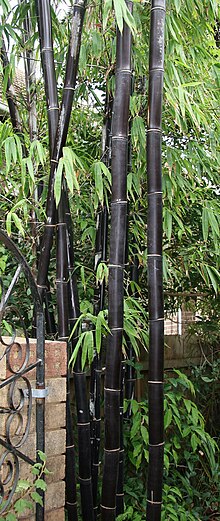
Alor is the largest island in the Alor Archipelago and is one of the 92 officially listed outlying islands of Indonesia. It is located at the eastern Lesser Sunda Islands that runs through southeastern Indonesia, which from the west include such islands as Bali, Lombok, Sumbawa, Komodo, and Flores.

The angklung is a musical instrument from the Sundanese in Indonesia that is made of a varying number of bamboo tubes attached to a bamboo frame. The tubes are carved to produce a resonant pitch when struck and are tuned to octaves, similar to Western handbells. The base of the frame is held in one hand, while the other hand shakes the instrument, causing a repeating note to sound. Each performer in an angklung ensemble is typically responsible for just one pitch, sounding their individual angklung at the appropriate times to produce complete melodies.
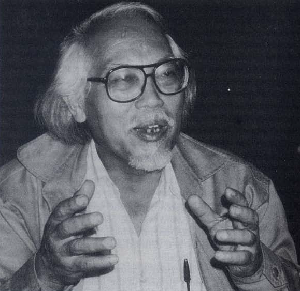
Yusuf Bilyarta Mangunwijaya, was an Indonesian architect, writer, and Catholic religious leader. He was popularly known as Romo Mangun.

Leptobrachium hasseltii is a species of toad found in Southeast Asia. This frog named after Dutch Naturalist Johan Conrad van Hasselt. According to the current understanding, this species is known with certainty only from Java, Madura, Bali, and Kangean Islands, Indonesia. The species is also commonly reported to occur in the Philippines, but these are believed to refer to another, unnamed species.
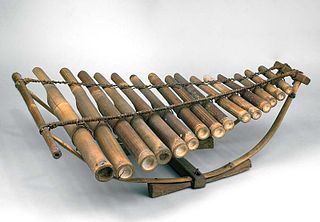
The Calung is a type of Indonesian bamboo xylophone originating from Baduy culture and commonly used in Baduy, Bantenese, Sundanese, Banyumasan, and Balinese performances. The calung (instrument) consists of multiple bamboo tubes which are struck at the base to produce a woody sound.

The Galuh Kingdom was a medieval Sundanese kingdom located in the eastern part of Tatar Sunda, present-day Indonesia. It was established as a breakaway kingdom of the Tarumanagara around the 7th century. Traditionally the kingdom was associated with the Central & Eastern Parahyangan cultural regions, with territory spanning from Citarum River in the west, to Cipamali and Cisarayu River in the east. Its capital was first located in Karangkamulyan, Ciamis Regency, then Saunggalah, Kuningan and Kawali, north of present-day Ciamis. The etymology of "galuh" is Old Sundanese and Kawi word for "gemstone".

Bambusa lako, known as Timor black bamboo, is a large species of bamboo originating from the island of Timor; its black culms may reach 21 m (69 ft) in height. A 2000 molecular study places it as closely related to the similar Indonesian species Gigantochloa atroviolacea, from which it was separated in 1997; it may soon be placed in that genus. Bambusa lako can only be grown in climates that are mostly frost-free.

Ajip Rosidi was an Indonesian poet and short story writer. As of 1983 he had published 326 works in 22 different magazines.
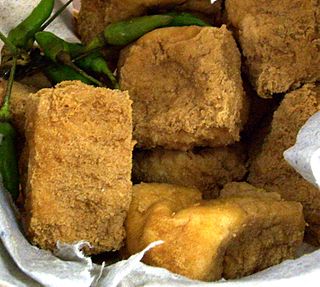
Tahu sumedang or Tahu bunkeng is a Sundanese deep-fried tofu from Sumedang, West Java, Indonesia. It was first made by a Chinese Indonesian named Ong Kino. It has some different characteristic from other tofu.

Misbach Yusa Biran was an Indonesian writer, director and columnist who pioneered the Indonesian film archives.

Sejarah Film 1900–1950: Bikin Film di Jawa is a 2009 history of the cinema of the Dutch East Indies written by Misbach Yusa Biran. It was published by Komunitas Bambu in collaboration with the Jakarta Arts Council and well received. The book was written by Biran before his death, three years later.

Panggilan Darah is a 1941 film from the Dutch East Indies written and directed by Sutan Usman Karim and produced by Tjho Seng Han for Oriental Film. The black-and-white film starred Dhalia and Soerip as orphaned sisters trying to make a living in the colonial capital of Batavia before moving to Kudus to work at a clove cigarette factory.

Pantjawarna is a 1941 film from the Dutch East Indies.

The Thousand Islands are a chain of islands to the north of Jakarta's coast. It forms the only regency of Special Capital Region of Jakarta, the metropolitan province of Indonesia. It consists of a string of 342 islands stretching 45 km (28 mi) north into the Java Sea at West Jakarta Bay and in fact are located to the north of Banten Province. Pramuka Island is the regency seat. The islands, along with North Jakarta City, are the only administrative divisions of Jakarta Special Capital Region with a coastline.
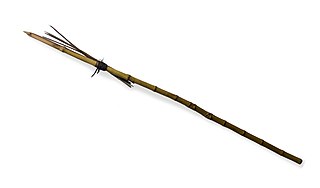
A bambu runcing or prìng lancìp is a traditional spear made of a sharpened bamboo.

Banyumasan or Banyumasan Javanese is a collective term for a Javanese subgroup native to the Indonesia's westernmost part of Central Java. At approximately ±9 million people, they are concentrated in Banyumas, Cilacap, Kebumen, Purworejo, Purbalingga, and Banjarnegara regencies. The Banyumasan-Javanese speak Banyumasan dialect of Javanese language, a dialect which is often called "basa ngapak-ngapak".

Sundanese Music is an umbrella term that encompasses diverse musical traditions of the West Java and Banten in western part of Java, Indonesia. The term of "West Java" is preferred by scholars in this field. The word "Sundanese" originally referred to western part of Java Island and has a strong association with the highly centralized Sunda Kingdom based on Java Island and its high culture practiced by the nobleman class in its capital Parahyangan. By contrast, scholars who cover a much broader region lay emphasis on folk culture.
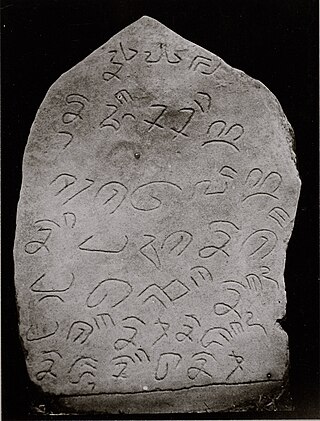
Old Sundanese is the earliest recorded stage of the Sundanese language which is spoken in the western part of Java, Indonesia. The evidence is recorded in inscriptions from around the 12th to 14th centuries and ancient palm-leaf manuscripts from the 15th to 17th centuries AD. Old Sundanese is no longer used today, but has developed into its descendant, modern Sundanese.

Buda Script or (Aksara Buda) or Gunung Script is an archaic script. Based on its shape, the Buda Script still has a close relationship with the Kawi script. This script was previously used on the island of Java and Bali. This type of script is called the Buda script because it is considered to have originated from the pre-Islamic era which is called the Buddhist Age. The word Buda is based on the Buddha word. Manuscripts containing writing using the Buda script are commonly found in mountainous areas. Because of that, this type of script is also called the "Mountain script".
